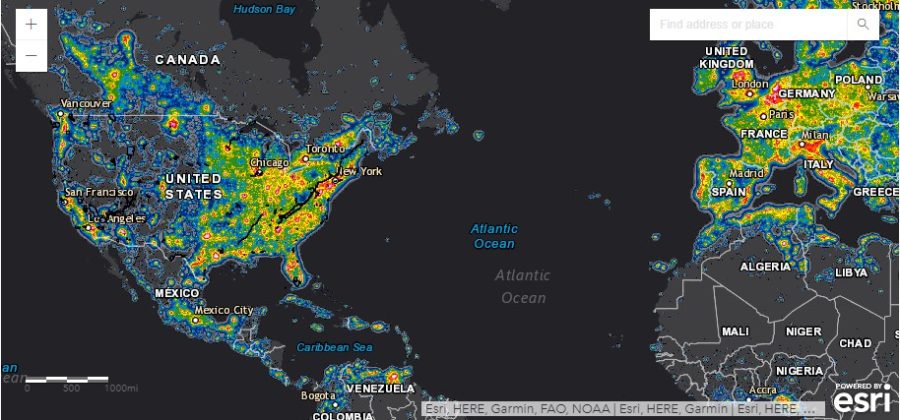Opinion: What’s Hiding the Sky?
This map is based on data published by a team of researchers led by Fabio Falchi and including NOAA’s Chris Elvidge and CIRES’ Kimberly Baugh.
As a kid, I was constantly pestered about turning off the yard lights when I came inside for the night. I hadn’t really understood why my parents stressed it so much, wasn’t I helping the animals see better through the dark? Later I realized that the lights weren’t helping the animals, but rather altering their natural environment, along with ours as well.
As time passes and new technologies progress, so does the widespread issue of light pollution, and it continues to alter the natural routine of living things. The lights from our homes is pollution that negatively affects the environment. Excessive amounts of unnecessary, artificial light, causes the beautiful night sky to fade into a vast glow of human tribulation.
Out of all the different types of pollution and damage that humans are causing the earth, light pollution is easily the one that goes most unrecognized.
There’s a reason why it’s not as stressed as soda rings swimming in the oceans, or plastic water bottles littering national forests, and it’s because most people don’t even realize light can be deemed as pollution.
How can someone be aware and upset if they don’t even realize that there’s an issue?
Light pollution is the result of uncontrolled, artificial light that is trapped above well-lit areas in the night sky. This causes stars, planets, and other things that are normally visible in space to be clouded over by a blanket of sky glow. Above cities and small towns, it’s near impossible to view the Milky Way, let alone the sea of stars and satellites. On especially foggy nights, the street lights and storefront LEDs accumulate in the sky, making for a clouded, red blanket overhead.
Though it may not be as apparent on clear nights, light pollution is present every day in nearly every inch of inhabited land. The majority of contributing light is produced by factories, advertising, and indoor/outdoor lighting. These contributing light sources may be crowded within a few miles radius, but the lasting effects can be carried through the dark sky much further than a couple of miles.
The National Parks Service Night Sky Team has documented light from over 200 miles away affecting night skies. Two hundred miles is an enormous distance and seems almost unfair for the surrounding wildlife that has a natural routine synced with nature to be affected as well. With the contributions of poor lighting designs and careless flip-switchers, the night sky is sadly being left polluted and unappreciated.
While it may seem like light pollution only limits our abilities to clearly view the night sky, it actually presents real concerns for the natural environment too.
The glow produced by light pollution can often disrupt the natural pattern of surrounding wildlife, disturb human sleep, and even contribute to the increase in carbon dioxide in the atmosphere according to National Geographic.
To add to the list of devastation, the increase in light at night time can also decrease contrast in the human eye, limiting the ability to see clearly in darker situations.
An article posted by the NCSL stated, “For humans, exposure to bright light at night can interfere with natural circadian rhythms” (Jennifer). This rhythm is the rise and fall of the sun over the 24- hour day, so when it is being meddled with, it causes the human body to experience things like sleep disorders.
The disruption of the rhythm can also affect where sea turtles decide to lay their eggs, and they may confuse street lights for the moonlight. When confused, baby turtles are often hit by cars on their journey back to the beach.
The potential dangers that are associated with light pollution should be enough to encourage companies and other energy consumers to dial down the brightness, except many of the users aren’t even aware of the consequences of too much light usage.
According to Ben Panko, over 83% of Earth’s population experiences a light-polluted sky every night. That means that only a small amount of people actually get to experience the raw night sky regularly.
People continue to build the next big sports stadium or shopping mall, while simultaneously ruining the night sky and discomposing the natural rhythms with the new lavish lighting arrangements. How long will it be until these innovators pump the brakes on creating new, poorly developed artificial light instead of researching new solutions to light pollution?








